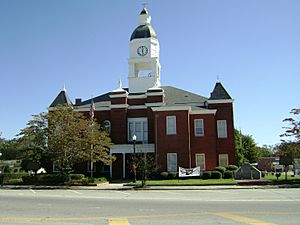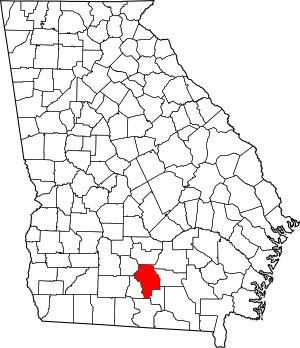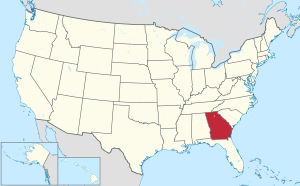Berrien County, Georgia facts for kids
Quick facts for kids
Berrien County
|
||
|---|---|---|

Berrien County courthouse in Nashville
|
||
|
||

Location within the U.S. state of Georgia
|
||
 Georgia's location within the U.S. |
||
| Country | ||
| State | ||
| Founded | 1856 | |
| Named for | John M. Berrien | |
| Seat | Nashville | |
| Largest city | Nashville | |
| Area | ||
| • Total | 458 sq mi (1,190 km2) | |
| • Land | 452 sq mi (1,170 km2) | |
| • Water | 6.0 sq mi (16 km2) 1.3%% | |
| Population
(2020)
|
||
| • Total | 18,160 | |
| • Density | 40/sq mi (20/km2) | |
| Time zone | UTC−5 (Eastern) | |
| • Summer (DST) | UTC−4 (EDT) | |
| Congressional district | 8th | |
Berrien County is a place in the south-central part of Georgia, a state in the United States. In 2020, about 18,160 people lived there. The main town, or county seat, is Nashville.
Berrien County was officially started on February 25, 1856. It was formed from parts of three other counties: Coffee, Irwin, and Lowndes. The county is named after John M. Berrien, who was a senator from Georgia.
Contents
History of Berrien County
How Berrien County Started
Before Berrien County was created, people living in this area had to travel very far to reach their county courthouses. For those in Lowndes County, the courthouse was in Franklinville or later Troupville. For those in Irwin County, it was in Irwinville.
Because of these long trips, citizens began asking for a new county as early as 1853. Their first attempt didn't work. But by 1856, they tried again, and this time, Berrien County was successfully formed.
Berrien County in World War I
During World War I, Berrien County lost many young men. This was partly because army groups were often formed from local areas.
About eight weeks before the war ended, 25 men from Berrien County were among 200 soldiers who died at sea. This happened off the coast of Scotland. Many of their bodies were brought back home for burial. Their names are carved on a special memorial. This memorial is located on the courthouse grounds in Nashville. It was one of the first sculptures by artist E. M. Viquesney called The Spirit of the American Doughboy.
Geography of Berrien County
Berrien County covers a total area of about 458 square miles. Most of this area, about 452 square miles, is land. The remaining 6 square miles, which is about 1.3%, is water.
The western part of Berrien County is in the Withlacoochee River area. This river flows into the larger Suwannee River. The eastern part of the county is in the Alapaha River area, which also flows into the Suwannee River basin.
Main Roads in Berrien County
Counties Next to Berrien County
- Irwin County - to the north
- Coffee County - to the northeast
- Atkinson County - to the east
- Lanier County - to the southeast
- Lowndes County - to the south
- Cook County - to the west
- Tift County - to the northwest
Towns and Cities in Berrien County
Cities
Towns
Unincorporated Communities
These are smaller places that are not officially cities or towns.
People and Population
| Historical population | |||
|---|---|---|---|
| Census | Pop. | %± | |
| 1860 | 3,475 | — | |
| 1870 | 4,518 | 30.0% | |
| 1880 | 6,619 | 46.5% | |
| 1890 | 10,694 | 61.6% | |
| 1900 | 19,440 | 81.8% | |
| 1910 | 22,722 | 16.9% | |
| 1920 | 15,573 | −31.5% | |
| 1930 | 14,646 | −6.0% | |
| 1940 | 15,370 | 4.9% | |
| 1950 | 13,966 | −9.1% | |
| 1960 | 12,038 | −13.8% | |
| 1970 | 11,556 | −4.0% | |
| 1980 | 13,525 | 17.0% | |
| 1990 | 14,153 | 4.6% | |
| 2000 | 16,235 | 14.7% | |
| 2010 | 19,286 | 18.8% | |
| 2020 | 18,160 | −5.8% | |
| 2023 (est.) | 18,570 | −3.7% | |
| U.S. Decennial Census 1790-18801890-1910 1920-1930 1930-1940 1940-1950 1960-1980 1980-2000 2010 |
|||
| Group | Number | Percentage |
|---|---|---|
| White (not Hispanic) | 14,396 | 79.27% |
| Black or African American (not Hispanic) | 1,934 | 10.65% |
| Native American | 22 | 0.12% |
| Asian | 80 | 0.44% |
| Pacific Islander | 10 | 0.06% |
| Other/Mixed | 673 | 3.71% |
| Hispanic or Latino | 1,045 | 5.75% |
In 2020, there were 18,160 people living in Berrien County. This was a small decrease from the 19,286 people counted in 2010. The county's population was highest in 1910, with 22,722 residents.
In 2022, the average household income in Berrien County was about $48,670 per year. About 23% of the people in the county lived below the poverty line. This means they had a very low income. Also, about 30% of children under 18 years old lived in poverty.
Most people in Berrien County follow Christianity. The largest Christian groups are Baptists and other Protestant churches. Methodists and Pentecostals are also present. The biggest single Christian group in 2020 was the Southern Baptist Convention.
Education in Berrien County
All students living in Berrien County attend schools that are part of the Berrien County School District.
See also
 In Spanish: Condado de Berrien (Georgia) para niños
In Spanish: Condado de Berrien (Georgia) para niños


